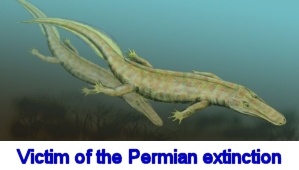
February Editorial
Rocks in the Canadian Arctic link Siberian Traps with Permian-Triassic extinction.

February Editorial
Rocks in the Canadian Arctic link Siberian Traps with Permian-Triassic extinction.
|
|
Life on earth is a risky business. There have been five major and several minor catastrophic events in the last 500 million years which have wiped out most living things on the planet. The greatest of all these extinctions happened 251 million years ago. It is known as 'the Permian-Triassic extinction event' and it killed off an estimated 90% of species existing at the time. This catastrophic event, which is less academically called 'the Great Dying', is thought to be the result of a massive basalt flood which is known to have happened in Siberia at the same time. |
|
|
A basalt flood is caused by a giant volcanic eruption (or series of eruptions) which coats large stretches of land or ocean floor with basalt lava. The flood basalt is primarily tholeiitic basalt - a type which has much less sodium than other basalts. Tholeittic basaltic magma is characterised by very low viscosity which allows it to flow freely, and therefore cover vast areas. Hence its name 'flood basalt'. The massive volcanic event in Siberia (called the Siberian Traps) 250 million years ago formed a region of volcanic rock known as a large igneous province (large accumulations of igneous rocks which are found in the earth’s crust). Today this covers an area of about 2 million square kilometers, or about the area of all western Europe. The original coverage was probably much greater - probably as large as 7 million km2 with the original volume of lava being estimated at 1-4 million cubic kilometers. Although the massive Siberian basaltic flood and the 'Great Dying' are generally accepted to be linked, direct evidence is largely lacking. It is undisputed that hot, rapidly flowing basaltic magma will destroy all life on its path. But how would a volcano in Siberia destroy life on the other site of the planet? The Siberian Traps lasted for 1 million years and volcanic activities were largely of pyroclastic nature. This would result in the emission of ash and gases which probably spread over a large area of the Earth. The emission of sulfur oxides created acid rain. A second major effect was the emission of greenhouse gases such as CO2. Recent studies just published in Nature Geoscience provide direct evidence that coal fly ash rom the Siberian Traps dispersed into the oceans during the Permian extinction. Stephen Grasby is a geoscientist with the University of Calgary and research scientist at Natural Resources Canada. He and and his colleagues found coal ash in rocks in the Canadian Arctic which date back to the Siberian volcanic eruptions. Analysis of terrestrial carbon in marine sediments showed that a large amount of char was deposited in Permian age rocks. The geochemical analysis of the char from those rocks linked it to the original source in Siberia. Stephen Grasby believes that flood basalts induced spontaneous combustion of Siberian coalfields and organic-rich sediments. This gave rise to a char which spread around the world. Char is very similar to modern coal fly ash, which can create very toxic marine conditions. In addition to the many toxic elements which fly ash contains (heavy metals, arsenic or radioactive particles), fly ash also contains lime (CaO). When lime is dispersed in water as slurry, it reacts with elements in the water to form calcium hydroxide (Ca(OH)2). The consequent very alkaline conditions (pH9 to pH10) are toxic to marine life. Reference Stephen E. Grasby, Hamed Sanei and Benoit Beauchamp. Catastrophic dispersion of coal fly ash into oceans during the latest Permian extinction. Nature Geoscience (2011), 4, pp. 104-107. | |
| _______________________________ | ||||
| Home | | | Shopping | | | Database |
© Biscuit Software 2004-2015
All rights reserved